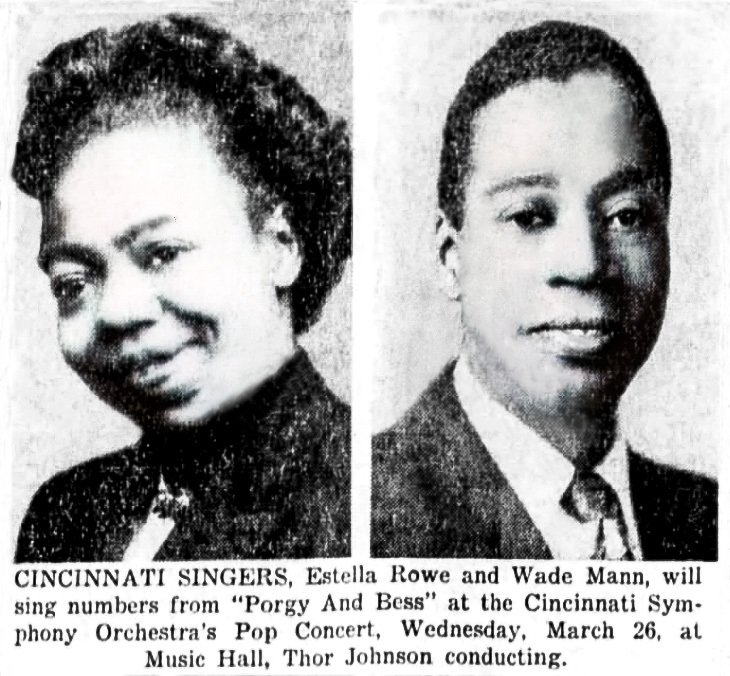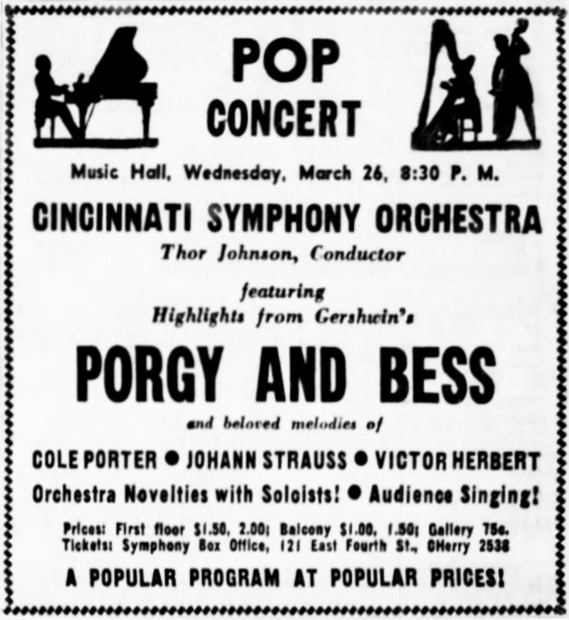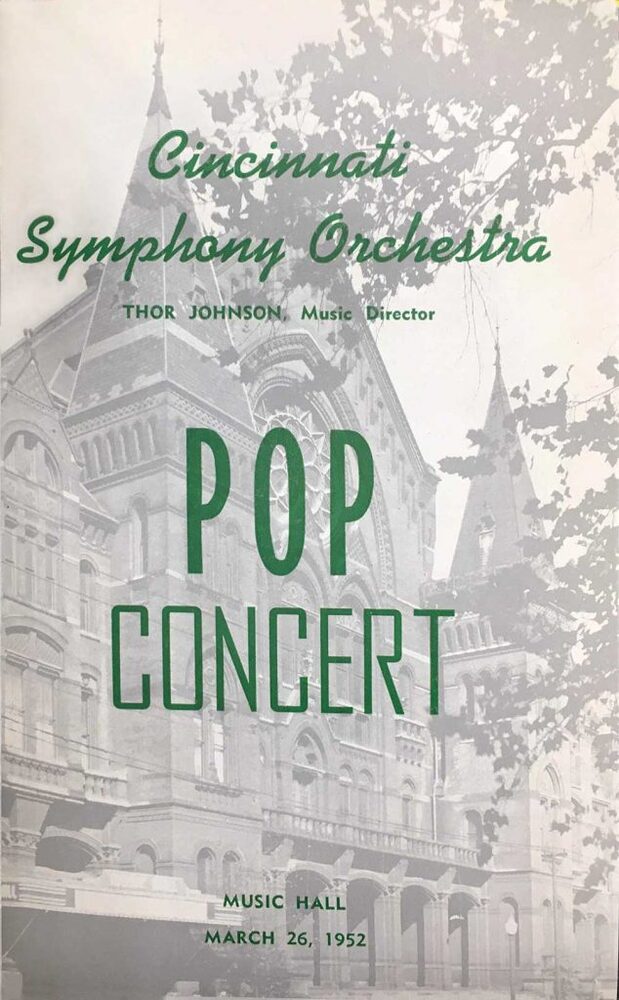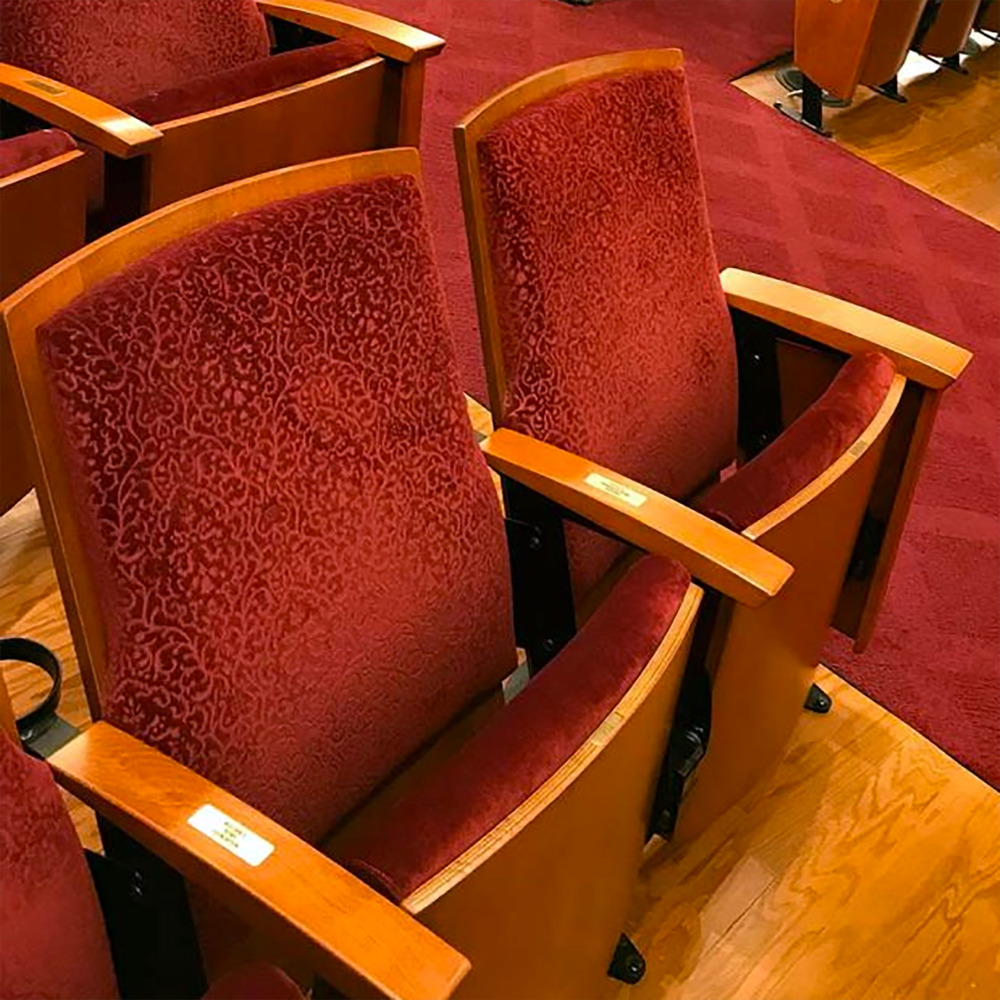Estella Rowe and Wade Mann
First Local Black Soloists with the Cincinnati Symphony Orchestra

Although Music Hall hosted numerous African American artists in its early days, 26 Mar 1952 was the first time that Black hometown singers performed in the Springer Auditorium with the Cincinnati Symphony Orchestra. Cincinnatians Estella Cavanaugh Rowe (26 Nov 1914-31 May 2000), soprano, and Wade Eugene Mann (2 Aug 1913-20 June 1993), bass, sang selections from Gershwin’s Porgy and Bess with the CSO during a Pops concert conducted by Thor Johnson, as the first local Black soloists to appear in a CSO subscription concert.
Both were classical singing students of Louis John Johnen, who had a voice studio in Clifton. Johnen was an accomplished baritone, a graduate of the University of Cincinnati, choral conductor of UC’s Oratorio Society, and sang in Cincinnati Zoo operas in the 1920s.
Prior to performing with the CSO, Mann and Rowe sang in many of Johnen’s student recitals in the late 1940s and early 1950s, and both were active singers in local choirs and gave numerous recitals in area churches.
Wade Mann was a member of Bethel Baptist Church, the YMCA Choral Group, and a cappella octet “The Cavaliers.” He also served four years in the Army during WWII.
Rowe, a member of the First Baptist Church in Walnut Hills, was often featured as a prominent soloist in the church choir. She served as the church secretary for 48 years, chaired musical programs and taught Sunday school. She was also was a talented actress in local and regional productions.
During the late 40s and early 50s, Rowe gained recognition as a frequent soloist in Cincinnati’s June Festivals, an annual African American choral festival founded in 1938 that provided opportunities for prominent Black, classically trained, soloists to appear in concerts with a mass choir. Black singers were banned from performing in the May Festival chorus until 1956. Until then, June Festival concerts were held outdoors, mostly at the Zoo auditorium and the Eden Park bandstand, where 100-300 singers from area community choirs, choral clubs, and gospel choirs would perform for huge crowds of up to seven thousand.
The Cincinnati Post, Cincinnati Times-Star and Cincinnati Enquirer all praised Rowe’s and Mann’s talents after their 1952 performance on the Music Hall stage.
Music critic (and the duo's vocal teacher) Louis John Johnen mentioned in his Cincinnati Times-Star review that, at the end of the concert while a reception was being held for the soloists, “militant handbills” were distributed outside of Music Hall’s doors. Johnen called the effort “misguided, ill-advised, and totally unnecessary.”
Although local African American public-school choirs with soloists had sung on the stage of Music Hall for early expositions and at the 1928 Golden Jubilee, the 1952 CSO concert featuring Estella Rowe and Wade Mann, was the first to engage and celebrate local Black professional artists and welcome them to the stage of Music Hall. The famous contralto Marian Anderson had performed a solo recital in Music Hall in 1944, but first appeared as a soloist with the CSO only a few months prior to this 1952 Pops concert. It would be another four years until the May Festival presented its first Black artists: Leontyne Price and William Warfield singing “The Ordering of Moses” by Black composer Nathaniel Dett in 1956.
It can be said that Estella Rowe and Wade Mann opened the doors of Music Hall for Black performers and audience members as well as the hearts and minds of white patrons who could finally experience the full breadth of musical expression within their community.
Donald Hurd became a lifelong friend of Estella Rowe’s after meeting her in the 1980s when he was a CCM student and took the job as an organist and choir director for the First Baptist Church. Rowe gave him his first tour of the church. Passing pictures of famous Black historical figures on the walls, Hurd told her of his deep interest in history. She replied, “I’m a part of history too, but no one is interested in my story.” He later discovered her remarkable story and has ensured that it continues to be told, especially in Cincinnati Music Hall.
Hurd purchased a plaque in Rowe’s honor, which is located on the arm of a chair in the Springer Auditorium's orchestra right, row N, seat 302.
Images



